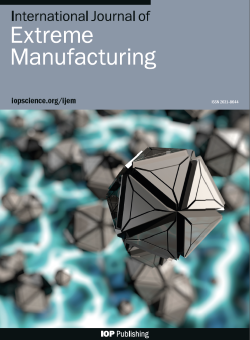利用 N2 原位添加制造具有梯度分层结构的高强度和延展性钛复合材料
IF 16.1
1区 工程技术
Q1 ENGINEERING, MANUFACTURING
引用次数: 0
摘要
如何协调钛材料强度与塑性之间的矛盾一直是一项具有挑战性的工作。激光粉末床熔融(LPBF)是制造创新复合材料(包括受梯度层状材料启发的复合材料)的一种便捷方法。在这项工作中,我们利用 LPBF,通过在 LPBF 过程中使用不同的 N2-Ar 比率,选择性地制备了 TiN/Ti 梯度层状结构 (GLSTi) 复合材料。我们利用显微分析、TEM表征和数字图像相关拉伸测试系统地研究了原位合成TiN的机理、GLSTi复合材料的高强度和延展性。此外,还建立了 N2 浓度与 LPBF 原位合成 TiN 体积分数之间的数字对应关系。结果表明,与纯氩气条件下通过 LPBF 制造的纯钛相比,GLSTi 复合材料表现出更优越的机械性能。具体而言,GLSTi 的拉伸强度比 LPBF 制成的纯钛高出 1.5 倍以上,达到 1100 兆帕,同时保持了 17% 的高断裂伸长率。GLSTi 打破了传统纳米陶瓷颗粒强化钛基复合材料强度高、延展性低的瓶颈,TiN/Ti 层状结构形成的异变形诱导强化效应解释了其强度-塑性平衡原理。显微硬度呈锯齿状变化,纯钛层硬度相对较低,为 245 HV0.2,而 N2 原位合成层硬度较高,为 408 HV0.2。我们的研究为三维打印钛基复合材料的结构-性能数字化定制提供了一个新概念。本文章由计算机程序翻译,如有差异,请以英文原文为准。
In-situ additive manufacturing of high strength yet ductility titanium composites with gradient layered structure using N2
It has always been challenging work to reconcile the contradiction between the strength and plasticity of titanium materials. Laser powder bed fusion (LPBF) is a convenient method to fabricate innovative composites including those inspired by gradient layered materials. In this work, we used LPBF to selectively prepare TiN/Ti gradient layered structure (GLSTi) composites by using different N2-Ar ratios during the LPBF process. We systematically investigated the mechanisms of in-situ synthesis TiN, high strength and ductility of GLSTi composites using microscopic analysis, TEM characterization, and tensile testing with digital image correlation. Besides, a digital correspondence was established between the N2 concentration and the volume fraction of LPBF in-situ synthesized TiN. Our results show that the GLSTi composites exhibit superior mechanical properties compared to pure titanium fabricated by LPBF under pure Ar. Specifically, the tensile strength of GLSTi was more than 1.5 times higher than that of LPBF-formed pure titanium, reaching up to 1100 MPa, while maintaining a high elongation at fracture of 17%. GLSTi breaks the bottleneck of high strength but low ductility exhibited by conventional nanoceramic particle-strengthened titanium matrix composites, and the hetero-deformation induced strengthening effect formed by the TiN/Ti layered structure explained its strength-plasticity balanced principle. The microhardness exhibits a jagged variation of the relatively low hardness of 245 HV0.2 for the pure titanium layer and a high hardness of 408 HV0.2 for the N2 in-situ synthesis layer. Our study provides a new concept for the structure-performance digital customization of 3D-printed Ti-based composites.
求助全文
通过发布文献求助,成功后即可免费获取论文全文。
去求助
来源期刊

International Journal of Extreme Manufacturing
Engineering-Industrial and Manufacturing Engineering
CiteScore
17.70
自引率
6.10%
发文量
83
审稿时长
12 weeks
期刊介绍:
The International Journal of Extreme Manufacturing (IJEM) focuses on publishing original articles and reviews related to the science and technology of manufacturing functional devices and systems with extreme dimensions and/or extreme functionalities. The journal covers a wide range of topics, from fundamental science to cutting-edge technologies that push the boundaries of currently known theories, methods, scales, environments, and performance. Extreme manufacturing encompasses various aspects such as manufacturing with extremely high energy density, ultrahigh precision, extremely small spatial and temporal scales, extremely intensive fields, and giant systems with extreme complexity and several factors. It encompasses multiple disciplines, including machinery, materials, optics, physics, chemistry, mechanics, and mathematics. The journal is interested in theories, processes, metrology, characterization, equipment, conditions, and system integration in extreme manufacturing. Additionally, it covers materials, structures, and devices with extreme functionalities.
 求助内容:
求助内容: 应助结果提醒方式:
应助结果提醒方式:


